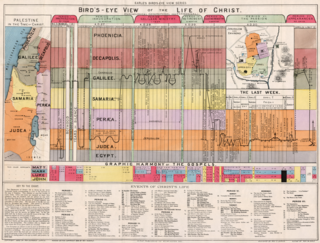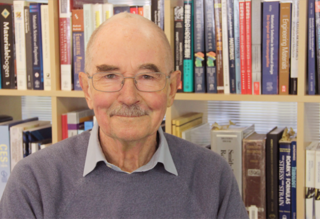
The Last Supper is the final meal that, in the Gospel accounts, Jesus shared with his apostles in Jerusalem before his crucifixion. The Last Supper is commemorated by Christians especially on Holy Thursday. The Last Supper provides the scriptural basis for the Eucharist, also known as "Holy Communion" or "The Lord's Supper".

The Cavendish Laboratory is the Department of Physics at the University of Cambridge, and is part of the School of Physical Sciences. The laboratory was opened in 1874 on the New Museums Site as a laboratory for experimental physics and is named after the British chemist and physicist Henry Cavendish. The laboratory has had a huge influence on research in the disciplines of physics and biology.

A chronology of Jesus aims to establish a timeline for the events of the life of Jesus. Scholars have correlated Jewish and Greco-Roman documents and astronomical calendars with the New Testament accounts to estimate dates for the major events in Jesus's life.

Sir Alan Howard Cottrell, FRS was an English metallurgist and physicist. He was also former Chief Scientific Advisor to the UK Government and vice-chancellor of Cambridge University 1977–1979.

The Department of Materials Science and Metallurgy (DMSM) is a large research and teaching division of the University of Cambridge. Since 2013 it has been located in West Cambridge, having previously occupied several buildings on the New Museums Site in the centre of Cambridge.
Dame Lynn Faith Gladden is the Shell Professor of Chemical Engineering at the University of Cambridge. She served as Pro-vice-chancellor for research from 2010 to 2016.

Michael Farries Ashby is a British metallurgical engineer. He served as Royal Society Research Professor, and a Principal Investigator (PI) at the Engineering Design Centre at the University of Cambridge. He is known for his contributions in Materials Science in the field of material selection.
Michael John Whelan HonFRMS FRS FInstP is a British scientist.
Peter John Goodhew is an electron microscopist who has published extensively on metallic and semiconducting materials and has authored or co-authored several widely used books on transmission electron microscopy. He was the leader of the UK SuperSTEM project at the STFC Daresbury Laboratory for ten years and has been Dean of Engineering and Pro-Vice-Chancellor at the University of Liverpool.

Brian Leonard Eyre CBE, FRS, FREng was a British material scientist, Chief Executive of the United Kingdom Atomic Energy Authority (UKAEA) and Professor at the University of Liverpool. He was also a visiting scholar at the University of Oxford and University College London.
Derek John Fray is a British material scientist, and professor at the University of Cambridge.

Sir John Vincent McCanny is the emeritus Regius Professor of Electronics and Computer Engineering at Queen's University Belfast, and director of the Institute of Electronics, Communications and Information Technology.

Dame Pratibha Laxman Gai-Boyes is a British microscopist and Professor and Chair of Electron Microscopy and former Director at The York JEOL Nanocentre, Departments of Chemistry and Physics, University of York. She created the atomic-resolution environmental transmission electron microscope (ETEM) and is an outspoken advocate for women with careers in science.

Raymond Edward Smallman was a British metallurgist and academic known for his research into alloys and the causes of metal fatigue. Smallman was also a significant figure at the University of Birmingham, serving as its vice-principal between 1987 and 1992 and helping to establish its reputation as a leading modern research university.

Paul O'Brien was professor of Inorganic Materials at the University of Manchester. where he served as head of the School of Chemistry from 2004 to 2009 and head of the School of Materials from 2011 to 2015. He died on 16 October 2018 at the age of 64.

The Department of Materials is responsible for the teaching and research in materials science and engineering at Imperial College London, occupying the Royal School of Mines and Bessemer buildings on the South Kensington campus. It can trace its origins back to the metallurgy department of the Government School of Mines and Science applied to the Arts, founded in 1851.
Peter David Nellist, is a British physicist and materials scientist, currently a professor in the Department of Materials at the University of Oxford. He is noted for pioneering new techniques in high-resolution electron microscopy.












